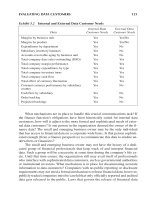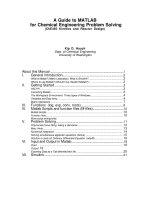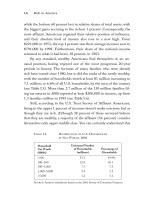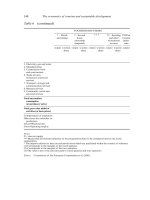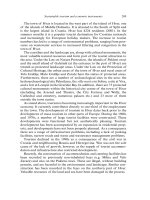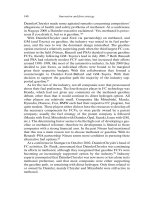101 activities foteaching creativity and problem solving phần 6 docx
Bạn đang xem bản rút gọn của tài liệu. Xem và tải ngay bản đầy đủ của tài liệu tại đây (333.1 KB, 41 trang )
42
Imaginary Mentor
Background
Did you ever have a secret friend to whom you told all your problems? Do you have an
inner voice that helps you solve problems? Are they out to get you?
If you answered yes to all three questions, you may want to obtain professional coun-
seling! If you answered yes to the first two questions, you may want to delay treatment.
Apparently, many people listen to an inner voice for guidance. For instance, General Dou-
glas MacArthur supposedly conjured up his hero-father for advice on military strategy.
The poet Milton called his inner guide “Celestial Patroness” and described how she
helped him compose his writings.
I’m not suggesting that we all have a little person living inside us. Instead, I believe
we all have subconscious motives, impulses, feelings, and images. All this material has
tremendous potential as a vast, untapped reservoir of creativity.
The problem is that we can’t always access our subconscious on demand. We have no
set of commands or buttons to push to enter our subconscious minds. Instead, we have to
enter them more indirectly. One way to access our subconscious thoughts is to create a
personal, internal mentor.
Objectives
• To help participants generate as many creative ideas as possible
• To help participants learn how to use the activities to generate ideas
Participants
Small groups of four to seven people each
Materials, Supplies, and Equipment
• For each group: markers, two flip charts, and masking tape for posting flip-chart
sheets
• For each participant: one sheet each of three different colors of sticking dots
(
1
⁄2” diameter) and one pad of 4 x 6 Post-it
®
Notes
193
Free Association Activities: “Blue Skies”
101 Activities for Teaching Creativity and Problem Solving. Copyright © 2005 by John Wiley &
Sons, Inc. Reproduced by permission of Pfeiffer, an Imprint of Wiley. www.pfeiffer.com
07 VG 167-216 10/6/04 12:17 PM Page 193
TLFeBOOK
Time
45 minutes
Related Activities
• Stereotype [10]
• We Have Met the Problem and It Is We [48]
• Super Heroes [80]
Procedure
1. Instruct the participants verbally as follows:
• Release all your tension and try to relax as much as possible.
• Visualize a soft, glowing white light surrounding your body. Allow the light to
make you feel secure and comfortable.
• Think of your favorite place (house, mountain, forest, stream, boat).
• Visualize yourself walking into this place. Notice all the details. Try to imagine
what it looks like. Experience any sounds, textures, or smells. Absorb as much
as you can.
• Imagine your personal mentor walking toward you. Look closely at his or her
face. What are you experiencing? Think of any special feelings or emotions.
Include as much detail as possible.
• Say to your mentor, “Please be my guide and help me think of new ideas. Lead
me in resolving my problem.”
• Tell your mentor about your problem. Give him or her as much relevant infor-
mation as you can. Try to keep your interaction realistic. Listen carefully when-
ever your mentor speaks to you. Don’t be discouraged if ideas don’t pop out
suddenly. It takes time.
2. Tell them to write down any ideas on Post-it
®
Notes (one idea per note) and place
them on flip charts for evaluation.
Debrief/Discussion
It is difficult to fathom the full potential of the human mind, especially the subconscious.
We should try to appreciate its ability to help us resolve problems. Imaginary Mentor is a
good start. However, some people may have difficulty being engaged by this technique. It
may be too abstract or esoteric and not concrete enough for them to respond with new
ideas. Try to engage the participants in a discussion about the usefulness of such visually
oriented approaches and what types of people might benefit most from them.
Also consider having participants debrief using the following questions:
• What was most helpful about this exercise?
• What was most challenging?
• What can we apply?
194
101 Activities for Teaching Creativity and Problem Solving
101 Activities for Teaching Creativity and Problem Solving. Copyright © 2005 by John Wiley &
Sons, Inc. Reproduced by permission of Pfeiffer, an Imprint of Wiley. www.pfeiffer.com
07 VG 167-216 10/6/04 12:17 PM Page 194
TLFeBOOK
• How would you rate the value of this exercise to helping us with this issue?
• Will this exercise be helpful in the future for other sessions?
• What did you learn?
• What will we be able to use from this exercise?
• What ideas were generated, and which ones were most interesting?
195
Free Association Activities: “Blue Skies”
101 Activities for Teaching Creativity and Problem Solving. Copyright © 2005 by John Wiley &
Sons, Inc. Reproduced by permission of Pfeiffer, an Imprint of Wiley. www.pfeiffer.com
07 VG 167-216 10/6/04 12:17 PM Page 195
TLFeBOOK
43
Lotus Blossom
Background
The lotus is a pinkish water lily. As with most flowers, lotus blossom petals are nested
together. Numerous petals radiate outward from the center, in ever-widening circles. One
petal leads to the next and so forth, just like free association. Perhaps there is the making
of an idea generation technique here!
This technique takes advantage of visualization, free association, and a structured
approach to creating idea stimuli. Yasuo Matsumura, president of Clover Management
Research (Chiba City, Japan) developed the Lotus Blossom Method of generating ideas
(also called the MY technique, after his Japanese initials).
Objectives
• To help participants generate as many creative ideas as possible
• To help participants learn how to use the activities to generate ideas
Participants
Small groups of four to seven people each
Materials, Supplies, and Equipment
• For each group: markers, two flip charts, and masking tape for posting flip-chart
sheets
• For each participant: one sheet each of three different colors of sticking dots
(
1
⁄2” diameter) and one pad of 4 x 6 Post-it
®
Notes
Handout
• Lotus Blossom Handout
Time
30 minutes
196
101 Activities for Teaching Creativity and Problem Solving
07 VG 167-216 10/6/04 12:17 PM Page 196
TLFeBOOK
197
Free Association Activities: “Blue Skies”
Related Activities
• Brain Mapping [36]
• Doodles [37]
Procedure
1. Distribute the Lotus Blossom Handout, review the exercise example with the par-
ticipants, and answer any questions they may have.
2. Tell each group to tape together two sheets of flip-chart paper, side-to-side, to a
wall or other hard surface such as a table.
3. Instruct them to replicate the drawing in Figure 7.3, starting with writing a central
theme (problem) in the center of the paper, as shown in Figure 7.3.
4. Have them think of related ideas and concepts and write them in the surrounding
circles, A through H.
5. Tell them to use each of these ideas as a separate central theme or problem for the
surrounding lotus boxes.
6. Encourage them to try to generate eight ideas for each of these themes and write
them in the surrounding boxes, 1 through 8.
Debrief/Discussion
Consider having participants debrief using the following questions:
• What was most helpful about this exercise?
• What was most challenging?
• What can we apply?
• How would you rate the value of this exercise to helping us with this issue?
• Will this exercise be helpful in the future for other sessions?
• What did you learn?
• What will we be able to use from this exercise?
• What ideas were generated, and which ones were most interesting?
07 VG 167-216 10/6/04 12:17 PM Page 197
TLFeBOOK
198
101 Activities for Teaching Creativity and Problem Solving
101 Activities for Teaching Creativity and Problem Solving. Copyright © 2005 by John Wiley &
Sons, Inc. Reproduced by permission of Pfeiffer, an Imprint of Wiley. www.pfeiffer.com
Lotus Blossom Handout
Suppose your problem involves ways to improve a wristwatch. Write “Improve a wrist-
watch” in the center of a sheet of paper. Then write eight related concepts in surrounding
circles: (a) watch hands, (b) wrist strap, (c) date, (d) time, (e) second hand, (f) battery, (g)
appointments, and (h) face. Next, generate ideas for each of these elements.
• Watch hands—different shapes on ends, different colors, different designs
• Wrist strap—buckles, metal, different colors, transparent, different widths
• Date—flashing, multicolored, icons for months, written out
• Time—voice activated, voice response, flashing lights
• Second hand—digital, complementary color, gold plated, variable speed
• Battery—recharge in wall outlet, owner can replace
• Appointments—record appointments, beeper reminder, link appointments with other
watches
• Face—celebrity faces, pictures of famous landmarks, spinning face
Figure 7.3. Lotus Diagram
07 VG 167-216 10/6/04 12:17 PM Page 198
TLFeBOOK
44
Say Cheese
Background
When we first think of new ideas, they often flit
about without defined shape. If we really concen-
trate, we can bring them into focus. These new ideas
then become images we can capture in our mind’s
eye.
Frame. Focus. Click. There the images are. It’s
almost as if we photograph them with a camera. Van-
Gundy (1983) used this comparison to suggest a pro-
cedure for stimulating ideas using an imaginary
camera.
Objectives
• To help participants generate as many creative ideas as possible
• To help participants learn how to use the activities to generate ideas
Participants
Small groups of four to seven people each
Materials, Supplies, and Equipment
• For each group: markers, two flip charts, and masking tape for posting flip-chart
sheets
• For each participant: one sheet each of three different colors of sticking dots
(
1
/2′′ diameter) and one pad of 4 x 6 Post-it
®
Notes
• Three sheets each of 8.5′′ x 11′′ paper and pens or pencils for each participant
Time
30 minutes
199
Free Association Activities: “Blue Skies”
101 Activities for Teaching Creativity and Problem Solving. Copyright © 2005 by John Wiley &
Sons, Inc. Reproduced by permission of Pfeiffer, an Imprint of Wiley. www.pfeiffer.com
07 VG 167-216 10/6/04 12:17 PM Page 199
TLFeBOOK
Related Activities
• Imaginary Mentor [42]
Procedure
1. Read the following to participants and ask them to respond individually:
“Imagine you are looking at your problem through the viewfinder of a camera. Frame the picture
and adjust the focus to view the entire problem in sharp detail. Move your mind forward or back-
ward to adjust the focus. Add light to improve your view. Then make the image blurry to change
perspective. Finally, add different lenses such as telephoto or wide angle to change perspectives
again. Continue to make adjustments until your problem is centered clearly in your mind’s eye.
Push your mental shutter-release button and allow a picture of the problem to develop in your
mind. Study the picture and try to absorb all relevant details. Write down on your paper any inter-
esting features such as size, shape, texture, smells, movement. Finally, examine your descriptions
and use them to prompt ideas.”
2. Have each participant share his or her ideas, in turn, with the other group mem-
bers, write them on Post-it
®
Notes (one idea per note), and place them on a flip
chart to be evaluated later. Encourage them to consider any new ideas that might
be prompted from others’ ideas.
Debrief/Discussion
This technique is very similar to Imaginary Mentor [42] in that participants must rely on
their visualization skills to help think of ideas. If any participants seem to struggle with
creating ideas, tell them to try “playing off” of others’ ideas. That is, let them know that
they don’t have to worry about their visualization abilities; instead, they can try to think
of other ideas based on those produced by others (of course, they still can think of their
own ideas!).
Also consider having participants debrief using the following questions:
• What was most helpful about this exercise?
• What was most challenging?
• What can we apply?
• How would you rate the value of this exercise to helping us with this issue?
• Will this exercise be helpful in the future for other sessions?
• What did you learn?
• What will we be able to use from this exercise?
• What ideas were generated, and which ones were most interesting?
200
101 Activities for Teaching Creativity and Problem Solving
101 Activities for Teaching Creativity and Problem Solving. Copyright © 2005 by John Wiley &
Sons, Inc. Reproduced by permission of Pfeiffer, an Imprint of Wiley. www.pfeiffer.com
07 VG 167-216 10/6/04 12:17 PM Page 200
TLFeBOOK
201
Free Association Activities: “Blue Skies”
45
Sense Making
Background
Our everyday language is colored by references to the five senses: “I hear you,” “I see
what you mean,” “I feel for you,” “That’s a tasty idea,” “I smell a rat!” Such phrases usu-
ally prompt a variety of sensory images, corresponding to whatever sense is involved.
These images, in turn, help communicate meaning and increase understanding.
Just as our senses allow us to experience different stimuli, sensory images can help us
experience the different perspectives needed to create ideas.
Objectives
• To help participants generate as many creative ideas as possible
• To help participants learn how to use the activities to generate ideas
Participants
Small groups of four to seven people each
Materials, Supplies, and Equipment
• For each group: markers, two flip charts, and masking tape for posting flip-chart
sheets
• For each participant: one sheet each of three different colors of sticking dots
(
1
/2′′ diameter) and one pad of 4 x 6 Post-it
®
Notes
• Three sheets each of 8.5′′ x 11′′ paper and pens or pencils for each participant
Handout
• Sense Making Ideas Handout
Time
30 minutes
07 VG 167-216 10/6/04 12:17 PM Page 201
TLFeBOOK
202
101 Activities for Teaching Creativity and Problem Solving
Related Activities
• Say Cheese [44]
• We Have Met the Problem and It is We [48]
Procedure
1. Read the following to participants and ask them to respond individually:
“Try to become as relaxed as possible. Breathe comfortably at an even rate. Listen to your breathing
and let all stress flow out. Think about your problem in detail and try to experience it. Quickly smell
it, see it, taste it, touch it, and hear it. Think of your sense of smell. Visualize different olfactory expe-
riences you’ve had. For instance, you might think about some flowers you once smelled. Now, how
might you use your sense of smell to generate ideas to solve your problem? Think of your sense of
sight. Visualize different sight experiences you’ve had that have affected you emotionally. Now, how
might you use your sense of sight to generate ideas to solve your problem? Continue this process
with your senses of taste, touch, and hearing. Think of emotional experiences involving each of
these senses.”
2. Ask them to consider what ideas they might have thought of and to write them
down on their individual sheets of paper. For sample ideas, refer them to the
handout.
3. Have each participant share his or her ideas, in turn, with the other group mem-
bers, write them on a Post-it
®
Note, and place them on a flip chart to be evaluated.
Debrief/Discussion
To help participants relate to this technique, you first might have them experience differ-
ent items using their senses. For instance, you might place a number of objects varying in
size and texture into a paper bag and have participants try to identify them using only
their sense of touch. Or ask them to identify visually an object in a picture when only a
small part of the object is visible. Although this technique may not be as “all-purpose” as
others, it could be good enough to spark some useful ideas—and that’s all it takes some-
times!
Also consider having participants debrief using the following questions:
• What was most helpful about this exercise?
• What was most challenging?
• What can we apply?
• How would you rate the value of this exercise to helping us with this issue?
• Will this exercise be helpful in the future for other sessions?
• What did you learn?
• What will we be able to use from this exercise?
• What ideas were generated, and which ones were most interesting?
07 VG 167-216 10/6/04 12:17 PM Page 202
TLFeBOOK
203
Free Association Activities: “Blue Skies”
Sense Making Ideas Handout
To illustrate this activity, consider a publisher’s problem of how to increase book sales.
Here are some ideas that this technique might spark:
• Smell: Produce books that contain fragrances that reflect literary themes.
• Sight: Include a page of slides to illustrate topics.
• Taste: Include free stamps to encourage book buyers to mail in coupons redeemable
for discounts on future book purchases.
• Touch: Make book covers with different textures that invite people to touch them.
Once people pick up a book, they will be more likely to buy it.
• Hearing: Put audio-digital computer chips (like those in greeting cards) in the inside
covers of books. When someone opens the front cover, the book says, “Buy me,
please!” or mentions some benefit of the book’s contents.
101 Activities for Teaching Creativity and Problem Solving. Copyright © 2005 by John Wiley &
Sons, Inc. Reproduced by permission of Pfeiffer, an Imprint of Wiley. www.pfeiffer.com
07 VG 167-216 10/6/04 12:17 PM Page 203
TLFeBOOK
46
Skybridging
Background
This technique involves working both forward and backward when generating ideas.
Engineers call this method “reverse engineering.” Doug Hall (1994) calls it Skybridging. It
is based on a general definition of a problem as a gap between a current and a desired
state of affairs. That is, we examine “what is” and “what should be” and then try to close
the gap by working toward the goal and then back toward the current problem state.
Thus, there may be many different roads to an objective.
Objectives
• To help participants generate as many creative ideas as possible
• To help participants learn how to use the activities to generate ideas
Participants
Small groups of four to seven people each
Materials, Supplies, and Equipment
• For each group: markers, two flip charts, and masking tape for posting flip-chart
sheets
• For each participant: one sheet each of three different colors of sticking dots
(
1
⁄2” diameter) and one pad of 4 x 6 Post-it
®
Notes
Handout
• Skybridging Handout
Time
20 minutes
204
101 Activities for Teaching Creativity and Problem Solving
07 VG 167-216 10/6/04 12:17 PM Page 204
TLFeBOOK
Related Activities
• Brain Mapping [36]
• Idea Links [41]
Procedure
1. Tell each group to tape together two sheets of flip-chart paper, side-by-side, to a
wall or other hard surface such as a table.
2. Distribute the Skybridging Handout, review the example with the participants,
and answer any questions they may have.
3. Have them write down, on the left side, one to three words that define where they
are today with respect to a current challenge (for example, if product improve-
ment is the concern, they would list a current product’s status).
4. Have them use one to three words and write them down, on the right side of the
paper, where they would like to be with respect to the challenge (for example,
what is the ideal result?).
5. Instruct them to draw a straight line between the current and desired states. Tell
them to write on this line a sure thing and a boring thing, both of which represent
ways to achieve the desired state.
6. Instruct them to draw another connecting line that bends in the middle, as shown
in Figure 7.4. On the left side of the line, they should list an obvious idea; on the
right side, a safe idea. Have them continue drawing lines and listing ideas as
shown in the figure until they have generated all possible ideas. Note that, as they
list ideas, they should try working from right to left on some of the lines.
7. After they have finished listing ideas, tell them to examine them and make any
impractical ideas more practical, write all practical ideas on Post-it
®
Notes, and
place them on a flip chart for evaluation.
Debrief/Discussion
You might want to note that words on the arches become more impractical the higher up
they are. The diagram makes it relatively easy to see the range of ideas. Another thing to
emphasize during this exercise is that the participants don’t have to be too concerned
with the “correctness” of their words or how concrete or abstract the ideas might be. The
important thing is to generate a diversity of ideas.
205
Free Association Activities: “Blue Skies”
101 Activities for Teaching Creativity and Problem Solving. Copyright © 2005 by John Wiley &
Sons, Inc. Reproduced by permission of Pfeiffer, an Imprint of Wiley. www.pfeiffer.com
07 VG 167-216 10/6/04 12:17 PM Page 205
TLFeBOOK
Skybridging Handout
Figure 7.4 shows a sample skybridge based on generating ideas for improving a flash-
light. The figure suggests several ideas, some directly and some indirectly:
Figure 7.4. Skybridging Example
206
101 Activities for Teaching Creativity and Problem Solving
101 Activities for Teaching Creativity and Problem Solving. Copyright © 2005 by John Wiley &
Sons, Inc. Reproduced by permission of Pfeiffer, an Imprint of Wiley. www.pfeiffer.com
07 VG 167-216 10/6/04 12:17 PM Page 206
TLFeBOOK
47
Tabloid Tales
Background
There you are, in line in the supermarket. The customer at the checkout counter just real-
ized she has to pay for her groceries. She slowly gets out her checkbook and begins writ-
ing. After several minutes you notice she has finally written down the date.
Unfortunately, it’s July and she’s had trouble remembering the date change from last
year! She wrote down last year’s date and has to start over.
You sigh and begin looking around for a distraction. You glance to your left at the
magazine rack and you see it: “GIRL, 10, GIVES BIRTH TO CALF THAT LOOKS LIKE
ELVIS.” The headline sears into your brain and you shake your head as you struggle to
reassert your rationality. You read on:
• WIFE MAKES SALAD DRESSING OF HUSBAND IN BLENDER
• BABY BORN WITH THREE HEADS, SIX TAILS, AND BLUE EYES
• WOMAN DIVORCES FROG—CLAIMS NO PRINCE
• BIGFOOT SPOTTED DANCING WITH ELVIS
• MAN GIVES BIRTH TO VW
• NEW DIET GROWS EXTRA TOES
• TRUCKER’S LUNG EXPLODES WHILE HE WAS SMOKING ON ROAD
• ALIENS RESPONSIBLE FOR LIGHT BULB BURNOUTS
You’ve just been victimized by tabloid headlines. But don’t fret. You can salvage
something positive from your experience by using tabloid headlines to prompt ideas.
Doug Hall (1994) developed Tabloid Tales to help people distort facts and gain new per-
spectives on their problems.
Objectives
• To help participants generate as many creative ideas as possible
• To help participants learn how to use the activities to generate ideas
Participants
Small groups of four to seven people each
207
Free Association Activities: “Blue Skies”
07 VG 167-216 10/6/04 12:17 PM Page 207
TLFeBOOK
Materials, Supplies, and Equipment
• For each group: markers, two flip charts, and masking tape for posting flip-chart
sheets
• For each participant: one sheet each of three different colors of sticking dots
(
1
⁄2” diameter) and one pad of 4 x 6 Post-it
®
Notes
• An assortment of tabloid weekly newspapers such as The Star, The National Enquirer,
and, especially, Weekly News
Handout
• Tabloid Tales Handout
Time
30 minutes
Related Activities
• A Likely Story [15]
• Fairy Tale Time [40]
Procedure
1. Distribute at least two tabloid publications to each group.
2. Distribute the Tabloid Tales Handout, review the example with the participants,
and answer any questions they may have.
3. Instruct each group to list four key facts about their problem, product, service, or
process.
4. Tell them to distort one aspect of each fact and make it sensational or more
provocative by stating it as a tabloid headline.
5. For inspiration, suggest that participants thumb through the tabloids.
6. Have them use the distorted facts and review of the tabloids to generate practical
ideas.
7. Direct them to write their ideas on Post-it
®
Notes and place them on the flip chart
for evaluation later.
Debrief/Discussion
This can be a fun exercise for the participants. As some research has suggested, humor
can enhance the creative output of groups. And many tabloid headlines and stories cer-
tainly can provoke mirth. However, the ideas in this exercise, while facilitated by humor,
mostly will emerge from the headlines. This is because they typically are unrelated to the
208
101 Activities for Teaching Creativity and Problem Solving
07 VG 167-216 10/6/04 12:17 PM Page 208
TLFeBOOK
209
Free Association Activities: “Blue Skies”
problem and thus capable of triggering unique ideas. Because of these two elements, be
sure to encourage the participants to have fun (although they may not need much
encouragement).
Also consider having participants debrief using the following questions:
• What was most helpful about this exercise?
• What was most challenging?
• What can we apply?
• How would you rate the value of this exercise to helping us with this issue?
• Will this exercise be helpful in the future for other sessions?
• What did you learn?
• What will we be able to use from this exercise?
• What ideas were generated, and which ones were most interesting?
07 VG 167-216 10/6/04 12:17 PM Page 209
TLFeBOOK
210
101 Activities for Teaching Creativity and Problem Solving
Tabloid Tales Handout
Assume you are an automobile insurance company and want to deal with the challenge
of how to reduce auto theft. Four key facts are (1) auto thieves don’t want to attract atten-
tion, (2) some cars are more likely to be stolen than others, (3) unlocked and unattended
cars with running engines are likely theft candidates, and (4) alarms will deter some
thieves. These facts suggest the following tabloid headlines:
• ELVIS SEEN HONKING HORNS OF PINK CADILLACS
• CAR THIEF HIDES CAR IN HIS PANTS
• PREVIOUSLY STOLEN CAR DRIVES SELF AWAY FROM THIEF
• STOLEN CAR BLOWS UP CLEVELAND
These headlines then prompt the following ideas:
• Car starts only when driver sings a specified Elvis song.
• Car starts only when driver’s rear end fits specially molded car seat
• Hot-wired cars stop running after one minute
• Car started without special code sprays knockout gas in face of driver
101 Activities for Teaching Creativity and Problem Solving. Copyright © 2005 by John Wiley &
Sons, Inc. Reproduced by permission of Pfeiffer, an Imprint of Wiley. www.pfeiffer.com
07 VG 167-216 10/6/04 12:17 PM Page 210
TLFeBOOK
48
We Have Met the Problem
and It Is We
Background
A primary counseling skill is empathy—the ability to see and feel something from anoth-
er’s perspective. Some people say we can’t really understand how others feel about some-
thing unless we can walk in their shoes and see the world with their eyes. “Change
perspectives and you change understanding” is a principle that underlies many idea gen-
eration activities and applies especially well to this one.
Try to become our problems and we’ll create new perspectives that may help spark
new ideas. Of course, we can’t literally become our problems. We can, however, bring life
to our problems and alter how we see them. For this reason, We Have Met the Enemy and
It Is We (with a nod to cartoonist Walt Kelly and his Pogo character) will probably work
best with problems involving inanimate objects. This doesn’t mean you shouldn’t try it
with people problems; it just may not be as effective.
Objectives
• To help participants generate as many creative ideas as possible
• To help participants learn how to use the activities to generate ideas
Participants
Small groups of four to seven people each
Materials, Supplies, and Equipment
• For each group: markers, two flip charts, and masking tape for posting flip-chart
sheets
• For each participant: one sheet each of three different colors of sticking dots
(
1
⁄2” diameter) and one pad of 4 x 6 Post-it
®
Notes
Handout
• We Have Met the Problem and It Is We Handout
211
Free Association Activities: “Blue Skies”
07 VG 167-216 10/6/04 12:17 PM Page 211
TLFeBOOK
212
101 Activities for Teaching Creativity and Problem Solving
Time
30 minutes
Related Activities
• Stereotype [10]
• Imaginary Mentor [42]
• What if. . . ? [49]
Procedure
1. Distribute the We Have Met the Enemy and It Is We Handout, review the example
with the participants, and answer any questions they may have.
2. Recite the following instructions to the groups: “Think about what your problem
would say, think, and feel about itself and its relation to its environment. What
bugs it? What does it like? What are its major concerns, challenges, and opportu-
nities? Write down your responses on a flip chart.”
3. Tell them to use their descriptions as stimuli to brainstorm ideas, write them on
Post-it
®
Notes, and place them on the flip chart for evaluation.
Variation
• Have individual group members take turns speaking the part of whatever object is
chosen.
Debrief/Discussion
This is an especially useful exercise for people who are good at fantasizing and being
playful. Because it requires users to suspend belief about inanimate objects talking, not
everyone may excel at using it. However, most groups will have one or two people who
can, and that’s usually all it takes. Other group members then can use their thoughts to
ignite ideas.
Consider having participants debrief using the following questions:
• What was most helpful about this exercise?
• What was most challenging?
• What can we apply?
• How would you rate the value of this exercise to helping us with this issue?
• Will this exercise be helpful in the future for other sessions?
• What did you learn?
• What will we be able to use from this exercise?
• What ideas were generated, and which ones were most interesting?
07 VG 167-216 10/6/04 12:17 PM Page 212
TLFeBOOK
213
Free Association Activities: “Blue Skies”
We Have Met the Problem
and It Is We Handout
Assume your organization wants to generate ideas to improve a wastebasket. The waste-
basket might “say” the following:
“I’m sick and tired of being emptied so often. The food and cigarette ashes smell
terrible. I also hate it when people bang me around and leave marks on my out-
side. It really irritates me when people knock me over and my insides spill out all
over the carpet. I just hate all the messes. And they’re not even my fault.
“There is one nice thing about being a wastebasket. I just love it when some
hotshot tries to impress his friends by throwing a paper wad in me from across
the room. If the paper wad hits my rim, I sometimes can jiggle a little and knock it
to the floor. This makes the hotshot look so foolish!”
This diatribe might spark the following ideas for improving a wastebasket:
• A built-in trash compactor
• A continuous roll of plastic lining that can be removed easily every time the
wastebasket is emptied
• A built-in slot for a fragrance dispenser
• Suction cups, clamps, or Velcro
®
for attaching the wastebasket to the floor or a desk to
prevent accidental spills
• A basketball-type net that can be raised above the rim for practicing paper wad shots
101 Activities for Teaching Creativity and Problem Solving. Copyright © 2005 by John Wiley &
Sons, Inc. Reproduced by permission of Pfeiffer, an Imprint of Wiley. www.pfeiffer.com
07 VG 167-216 10/6/04 12:17 PM Page 213
TLFeBOOK
214
101 Activities for Teaching Creativity and Problem Solving
49
What if ?
Background
What if cows could fly?
What if we grew telephones in our ears?
What if we were all thumbs?
What if diamonds were soft and cushions were rock hard?
What if plants could talk?
What if people who asked “What if. . . ?” all the time suddenly died?
Do you get the idea? As you read each of these questions, images formed in your
mind. Most of these images probably were rather provocative. At least, they were a little
out of the ordinary. Any time our minds encounter contradictions or paradoxical think-
ing, we experience a perspective shift. In this case, asking “What if. . . ?” frees our minds
and opens them to possibilities we might never have thought of or explored. Asking
“What if. . . ?” pushes out the boundaries of impossibilities and limits.
Objectives
• To help participants generate as many creative ideas as possible
• To help participants learn how to use the activities to generate ideas
Participants
Small groups of four to seven people each
Materials, Supplies, and Equipment
• For each group: markers, two flip charts, and masking tape for posting flip-chart
sheets
• For each participant: one sheet each of three different colors of sticking dots
(
1
⁄2” diameter) and one pad of 4 x 6 Post-it
®
Notes
Handout
• What if. . . ? Handout
07 VG 167-216 10/6/04 12:17 PM Page 214
TLFeBOOK
215
Free Association Activities: “Blue Skies”
Time
30 minutes
Related Activities
• Get Crazy [5]
• Imaginary Mentor [42]
• We Have Met the Problem and It Is We [48]
Procedure
1. Read the above Background information to the participants.
2. Distribute the What if. . . ? Handout, review the example with the participants,
and answer any questions they may have.
3. Instruct the participants to brainstorm within their groups by saying the
following:
“Stretch your problem in as many ways as you can think of by asking ‘What if. . . ?’ Assume any-
thing is possible. Don’t worry about what won’t work or why something can’t be implemented. Just
let your mind go. Have someone in your group write down all of the ‘What if. . . ?’ statements on a
flip chart.”
4. After they are finished writing, say the following:
“Return to reality and examine each question while thinking, ‘Well, we can’t do that, but maybe we
can. . . .’ Brainstorm ideas by finishing this sentence and generate more practical ideas. Record all
your ideas individually on Post-it® Notes and place them on flip-chart paper.”
Debrief/Discussion
What if. . . ? is one of the simplest, yet most powerful, activities available. It is often over-
looked, however, because it is so simple. If participants truly suspend belief during this
exercise, the results can be outstanding. Ask participants how they think this approach
compares with more traditional brainstorming activities and why.
Also consider having participants debrief using the following questions:
• What was most helpful about this exercise?
• What was most challenging?
• What can we apply?
• How would you rate the value of this exercise to helping us with this issue?
• Will this exercise be helpful in the future for other sessions?
• What did you learn?
• What will we be able to use from this exercise?
• What ideas were generated, and which ones were most interesting?
07 VG 167-216 10/6/04 12:17 PM Page 215
TLFeBOOK
What if ? Handout
What if you were a car dealer who wanted to increase repeat business? To think of ideas,
you might begin “Whatiffing” as follows:
• What if I gave repeat customers a free car?
• What if prospective repeat customers had to beg to let me sell them a new car?
• What if prospective repeat customers tried to pay double the price for a new car?
• What if a customer’s current car hypnotized the customer into buying another car?
• What if new cars followed people around town until the people bought them?
Next, use these questions as idea triggers. Here are some sample ideas:
• I can’t give repeat customers a free car, but I could give them a substantial discount.
• I can’t get repeat customers to beg me to sell them a new car, but I could contact cus-
tomers on a regular basis to see if they have any problems. Such constant attention
may encourage repeat sales.
• I can’t double the price for a new car, but I could offer to pay customers double the
difference of any better car deal they can get from another dealer.
• A customer’s car won’t hypnotize the customer into buying another car, but I could
mount a relentless advertising campaign using all media.
• New cars won’t follow customers around, but I could offer repeat customers free use
of a cellular car phone for one year.
216
101 Activities for Teaching Creativity and Problem Solving
101 Activities for Teaching Creativity and Problem Solving. Copyright © 2005 by John Wiley &
Sons, Inc. Reproduced by permission of Pfeiffer, an Imprint of Wiley. www.pfeiffer.com
07 VG 167-216 10/6/04 12:17 PM Page 216
TLFeBOOK
Chapter 8
Grab Bag: Miscellaneous Activities
O
pen the bag. Now reach right in and help yourself. Grab whatever you find. Don’t be
shy; take a risk and see what you get. You’ll never know if you don’t try.
A grab bag can’t be beat when it comes to surprises. You never know what you’re
going to get. That also is true of this chapter. You don’t know what you’re going to get
because this chapter contains miscellaneous activities.
Grab bag activities actually involve two different types of idea stimulators. The first
type, “backward,” includes activities that involve reversing or turning around a problem
in some way. The second, “just alike only different,” contains activities based on analogi-
cal thinking; that is, they generate ideas by focusing on similarities between a problem
and something else.
Because these two types force us to look at our problems differently, these activities
are especially useful for creating unique perspectives. Thus, the activities in this chapter
possess considerable diversity in their approaches to generating ideas.
NOTE: FOR ALL ACTIVITIES, REMIND PARTICIPANTS
TO DEFER JUDGMENT WHILE GENERATING IDEAS.
“Backward”Activities: Reversals
Backward activities stimulate your brain by forcing you to reverse problem aspects and
view things differently. This opposite tactic is not what most people expect to use when
generating ideas. The typical reaction is to plunge right in and attack a problem by gener-
ating solutions—definitely a direct approach.
The point is, however, that reversals avoid the tendency to lock in on just one way of
viewing a problem. Divergent, creative thinking requires many problem viewpoints.
LLLL
217
08 VG 217-244b 10/5/04 5:00 PM Page 217
TLFeBOOK


